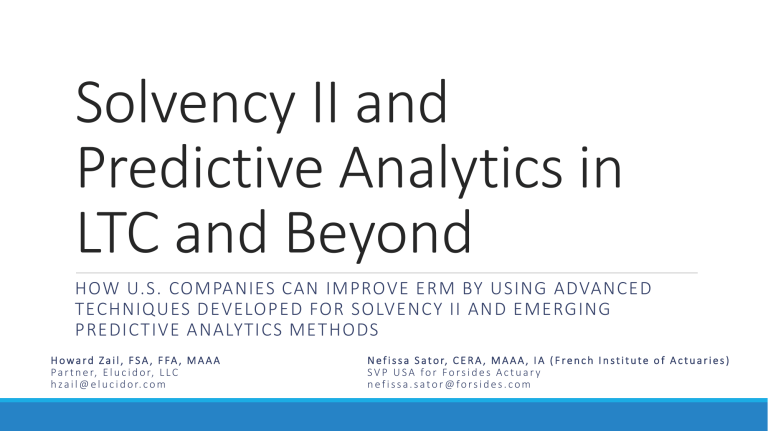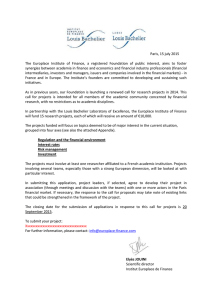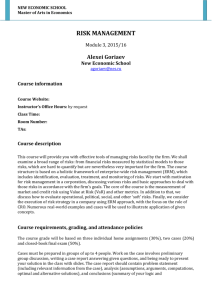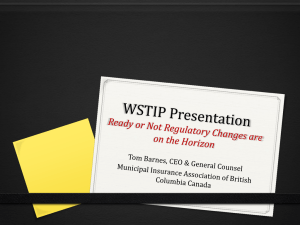Solvency II and Predictive Analytics in LTC

Solvency II and
Predictive Analytics in
LTC and Beyond
HOW U.S. COMPANIES CAN IMPROVE ERM BY USING ADVANCED
TECHNIQUES DEVELOPED FOR SOLVENCY II AND EMERGING
PREDICTIVE ANALYTICS METHODS
H o w a r d Z a i l , F S A , F FA , M A A A
P a r t n e r, E l u c i d o r, L L C h z a i l @ e l u c i d o r. c o m
N e f i s s a S a t o r, C E R A , M A A A , I A ( F r e n c h I n s t i t u t e o f A c t u a r i e s )
S V P U S A f o r F o r s i d e s A c t u a r y n e f i s s a . s a t o r @ f o r s i d e s . c o m
Presenters
Howard Zail, FSA, FFA, MAAA
Partner, Elucidor, LLC hzail@elucidor.com
Nefissa Sator, CERA, MAAA, IA (French Institute of Actuaries)
SVP USA for Forsides Actuary
Co-chairperson of the joint SOA / IA LTCI workshop nefissa.sator@forsides.com
Framework of Our Talk
Solvency II
Framework
ERM
Advanced
Predictive
Analytics
Using Solvency II
Techniques to Develop A
U.S. ERM Program
Introduction
Why the subject of LTC ?
Social issue
Uncertainties about the extent of the future situation
Relatively new risk
High potential of business development for insurers
Facing this long term, evolving, and still relatively unknown risk, the ERM approach contributes to
Manage the risks
Determine the Solvency Capital Requirement
Design the future products
We will be discussing Solvency II / ERM in the context of LTC, but the application can be broadly applied across other life businesses
French LTC Market, the Big Picture
The first contracts were issued in the mid 1980s
About 25 insurers participate in the market
Most business is heavily reinsured
Product structures include
Stand-alone individual LTC with life-time benefits
Group policies with fixed benefit period or lifetime options
LTC Riders attached to other life products
LTC embedded with health products
Second largest market in the world after the U.S.
5.7 million of insureds
€660 million of which 75% is generated by traditional insurance companies
Paid claims around €236 million per year, 24,700 claims (annuities) in service
Technical reserves estimated about €4.6 billion
Solvency II Increases Capital Requirement by 12x
Solvency II does not provide explicit technical specification for LTC
Stress tests not calibrated for LTC
No correlation between longevity and disability risks
No Entity Specific Standard Formula yet developed and implemented
This results in a much higher capital requirement
Solvency II Capital = 12 x Solvency I Capital
ERM process is critical to produce profitable business
Source of Solvency Capital Requirement (SCR)
Source
Mortality
Longevity
Disability
Expenses
Lapses
Total
% of Underwriting SCR
0%
47%
45%
1%
7%
100%
Governance and Risk Management, Pillar 2
1
Identify the Risks
5
Optimize the Risk Reduction
Measures
BOARD
Risk
Committee
LTC Experts committee
2
Define the Key Risk Indicators
4
Develop an Adapted Risk
Culture
3
Determine the Management
Actions
1. Identify the Risks
Evolution of regulation
Reputation
RISK
Anticipate
Prevent
Basis RISK Monitor
Participate in the market debate
Market watch
Scenario-based valuation
Client communication
Follow-up of client complaints
Gradual pricing increase over years
Organize the portfolio experience return
Model RISK
Outsourcing
RISK
Reduce
Limit
Documentation, Control, Audits
Sensitivity tests
Write service agreements and guidelines
Control
2. Define the Key Risk Indicators
ESSENTIAL ELEMENT ‘THE DATA’
KEY RISK INDICATORS ‘KRI’
Mortality and Incidence Rates
Lapses and Non-Forfeiture
Discount Rates
Underwriting and Claims Acceptance
Monitor the technical, financial and management risks
Justify assumptions
Alert in case of surpassing limits and correction measures
Reporting to the “LTC Experts Committee” and “Risk Committee”
3. Determine the Management Actions
Define the premium rate increase policy
Based on the key risk indicators
Taking into account the insured behavior
Using the long-term duration of the contracts
Reintroducing benefit revaluation
Scenario
(1) +3% p.a. during 10 years
(2) +3% p.a. during 10 years and double termination rates
(3) +3% p.a. during 10 years, double termination, and increase benefit level 0.5%
∆SCR Underwriting
-40%
-35%
-20%
Reduce the reputation risk
Confirm the assumptions
Indexed premium
+ revaluation of benefits in a longterm process
4. Develop an Adapted Risk Culture
Relevant and efficient communication at all levels, with illustrations
Transform the KRI in visual indicators easily understandable
Traffic light symbols to communicate the claims experience
Illustrate the risk characteristics
Breakdown of the liabilities by age of occurrence
100%
80%
60%
40%
20%
92 y and +
85 - 91 y
- 85 y
0%
1/3 of the incidence rate is not yet observed
4. Develop an Adapted Risk Culture
Provide figures for the 2 components of the Active Lives Reserve
500.00
400.00
300.00
future claims future premium
ALR
200.00
100.00
-
Change the risk culture
The company, the sales force and policyholder should expect annual premium increase like in health insurance or P&C.
In the French market, LTC is a long term policy but with non-life premium mechanisms.
5. Optimize the Risk Reduction Measures
OTHER MONITORING TOOLS
Reinsurance
Increase ceded shares
Transfer risk and reduce capital needs
The Reinsurer brings expertise (can not be considered Best Estimate)
Pay attention to the treaty wording
Diversification with other risks
Package LTC and death risk
Additional reserves ‘Equalization Reserve’
Maintain even if not recognized by Solvency II
Constitutes equity
Monitoring tool for short and mid-term evolutions and earnings
Conclusion
Solvency II increases Capital by
12x
This necessitates an
ERM process to ensure long-term viability of the business
ERM, in turn, improves future product development and company embedded value
Using New Advanced
Predictive Analytics
Techniques within an ERM
Program
What are Predictive Analytics?
Professional
Experience /
Insight
Prior
Information
Actuarial
Science /
Statistics
Algorithms
/ Modeling
Machine
Learning /
Pattern
Recognition
Predictions
Improved
Insight
Data
18
What is Different Now?
New
Players
Improved
Algorithms and
Techniques
More
Powerful
Hardware
Vastly
Improved
Software
Profoundly
Improved
Analytics
19
Using Predictive Analytics in a
U.S. ERM Program
Internal Risk Model
Level of Risk
Volatility of Risk,
Correlation among Risks
Our Focus Today
There are many methods, techniques within
Predictive Analytics toolbox
We will focus on one very powerful, flexible technique which has broad application:
State Space Modeling
State Space Modeling
State Space
Modeling
Interest Rate
Risk
Longevity
Internal Risk Model
Level of Risk
Volatility of Risk,
Correlation among Risks
A Battle Ships Game Analogy
State t
=
Actual
Position of
Ship at time t
Observation t
=
Noisy Radar
Reading at time t t t+1
State
A Bayesian Network Representation
State
1
State
2
State
3
Observation Obs
1
Obs
2
Obs
3
Solving the Model
The techniques used to solve state space models are often not trivial
But, there is extensive literature to help
Our preferred method:
Full Bayesian Model, solved using Markov chain Monte Carlo techniques
Advantages:
Provides a complete solution
Method is adaptable across many projects
Disadvantages:
Requires lots of computing power (and potentially time)
A Longevity Risk Analysis Example
Model: 𝑞 𝑥 𝑞 𝑡 𝑥
𝑇𝑀𝑀 𝑡 𝑞 𝑡 𝑥
= 𝑚𝑜𝑟𝑡𝑎𝑙𝑖𝑡𝑦 𝑟𝑎𝑡𝑒𝑠 𝑓𝑟𝑜𝑚 𝑎 𝑔𝑖𝑣𝑒𝑛 𝑡𝑎𝑏𝑙𝑒 𝑒. 𝑔. 𝑉𝐵𝑇 2008
= 𝑚𝑜𝑟𝑡𝑎𝑙𝑖𝑡𝑦 𝑟𝑎𝑡𝑒𝑠 𝑎𝑡 𝑡𝑖𝑚𝑒 𝑡 𝑎𝑑𝑗𝑢𝑠𝑡𝑒𝑑 𝑓𝑜𝑟 𝑖𝑚𝑝𝑟𝑜𝑣𝑒𝑚𝑒𝑛𝑡
= 𝑇𝑜𝑡𝑎𝑙 𝑀𝑜𝑟𝑡𝑎𝑙𝑖𝑡𝑦 𝑀𝑢𝑙𝑡𝑖𝑝𝑙𝑒 𝑎𝑡 𝑡𝑖𝑚𝑒 𝑡
= 𝑇𝑀𝑀 𝑡
∗ 𝑞 𝑥
Questions:
What are 𝑇𝑀𝑀 𝑡 for t= 0 to T
What is the confidence interval round each 𝑇𝑀𝑀 𝑡
How are 𝑇𝑀𝑀 𝑡 expected to evolve in the future
State
Longevity Risk State Space Representation
TMM
0
TMM
1
TMM
2
Observation
Deaths &
Survivals
0
Deaths &
Survivals
1
Deaths &
Survivals
2
The Full Bayesian Longevity Model
State
Observation
𝑇𝑀𝑀 𝑡
= 𝑇𝑀𝑀 𝑑𝑒𝑎𝑡ℎ 𝑖𝑛𝑠𝑢𝑟𝑒𝑑 𝑡−1 𝑡
+ 𝛽 + 𝜂 𝑡
~𝐵𝑒𝑟𝑛𝑜𝑢𝑙𝑙𝑖 𝑇𝑀𝑀 𝑡
. 𝑞 𝜂 𝑡
~ 𝑁𝑜𝑟𝑚𝑎𝑙 𝑚𝑒𝑎𝑛 = 0, 𝑠𝑑 = 𝜎 𝜂 𝑥 +𝑡
Prior Assumptions: 𝛽 ~ 𝑁𝑜𝑟𝑚𝑎𝑙 𝑚𝑒𝑎𝑛 = 𝜇 𝛽
, 𝑠𝑑 = 𝜎 𝛽
… 𝑡𝑟𝑒𝑛𝑑 𝑐𝑜𝑒𝑓𝑓𝑖𝑐𝑖𝑒𝑛𝑡
𝑇𝑀𝑀 𝜎 𝜂
0
~ 𝑁𝑜𝑟𝑚𝑎𝑙 𝑚𝑒𝑎𝑛 = 𝜇
~ 𝑁𝑜𝑟𝑚𝑎𝑙 0, .1 & 𝜎 𝜂
> 0
𝑇𝑀𝑀
, 𝑠𝑑 = 𝜎
𝑇𝑀𝑀
* The above model is somewhat of a simplification to the one we use in practice but is useful for pedagogical purposes
Hypothetical Example
Background:
50,000 Insured lives, male and female, aged 40 to 60
Followed for 10 years
True (but unknown) Mortality:
90% of 2008 VBT at issue (TMM
0
= 90%)
Mortality Improvement = 1% p.a. for 4 years, 2% p.a. thereafter
Approach:
Simulate Mortality based on true mortality
Use State Space Model on simulated outcomes to “reverse engineer” true mortality
Assumed Mortality Assumptions
Simulated Mortality
State Space Model
State Space Model with 10% to 90% Confidence Interval
Advantage of the State Space Approach
We now understand how mortality has evolved over the investigation period
State space terminology: “smoothed” set of TMM states
We have a best estimate for the current level of TMM rather than an average over the investigation
State space terminology: “filtered” TMM states
We know the average trend in mortality improvement, and the uncertainty/volatility of this estimate
We know what the confidence interval of our estimates for the current TMM
The confidence interval shrinks with more data (deaths)
We can project TMM going forward with a data driven estimate for the volatility (uncertainty) associated with
Current TMM value; Improvement Trend
We do not need to guess as to what reasonable sensitivity test level should be
An Interest Rate Risk Example
Motivation:
Duration-based ALM encapsulates parallel changes in yield curve well, but not changes in shape of the yield curve
Many arbitrage-free models do not show good historical empirical fits to the data
Uncertainty as to how to estimate the degree of volatility in interest rates when setting capital levels
State Space Approach to Interest Risk
Fit a Parametric Curve to Yield Curve at each point in time
Adopt a dynamic approach to model
Nelson-Siegal
Model
Implement in ERM
Use a state space to represent changes in the parameters of the Nelson Siegal
Curve
Use same model to project yield curve going forward to estimate interest rate risk exposure
The Dynamic Nelson-Siegal Model
𝑦 𝑡 𝜏 = 𝑦𝑖𝑒𝑙𝑑 𝑎𝑡 𝑡𝑖𝑚𝑒 𝑡 𝑓𝑜𝑟 𝑑𝑢𝑟𝑎𝑡𝑖𝑜𝑛 𝜏
1 − 𝑒 −𝜆𝜏 𝑦 𝑡 𝜏 = 𝑙𝑒𝑣𝑒𝑙 𝑡
+ 𝑠𝑙𝑜𝑝𝑒 𝑡
.
𝜆𝜏
+ 𝑐𝑢𝑟𝑣𝑎𝑡𝑢𝑟𝑒 𝑡
.
1 − 𝑒 −𝜆𝜏 𝜆𝜏
− 𝑒 −𝜆𝜏 + 𝜂 𝑦𝑖𝑒𝑙𝑑,𝜏 𝑠𝑡𝑎𝑡𝑒 𝑡 = 𝑙𝑒𝑣𝑒𝑙 𝑡 𝑠𝑙𝑜𝑝𝑒 𝑡 𝑐𝑢𝑟𝑣𝑎𝑡𝑢𝑟𝑒 𝑡 𝑠𝑡𝑎𝑡𝑒 𝑡 ~ 𝑛𝑜𝑟𝑚𝑎𝑙 𝑚𝑒𝑎𝑛 = 𝜇 𝑠𝑡𝑎𝑡𝑒
+ 𝜌 𝑠𝑡𝑎𝑡𝑒 𝑡 − 1 − 𝜇 𝑠𝑡𝑎𝑡𝑒
, 𝑠𝑑 = 𝜎 𝑠𝑡𝑎𝑡𝑒 𝜂 𝑦𝑖𝑒𝑙𝑑,𝜏
~ 𝑛𝑜𝑟𝑚𝑎𝑙(𝑚𝑒𝑎𝑛 = 0, 𝑠𝑑 = 𝜎 𝑦𝑖𝑒𝑙𝑑,𝜏
)
State
Interest Risk State Space Representation
Level,
Slope,
Curvature
1
Level,
Slope,
Curvature
2
Level,
Slope,
Curvature
3
Observation
Yield
Curve
1
Yield
Curve
2
Yield
Curve
3
Historic Dynamic Fit of Model
Press Shift F5 to view dynamic fit
Yield Curve Projections
Press Shift F5 to view dynamic fit
Possible Extensions to the model
Regime Switching: Include a “regime” change element to reflect the fact that current rates are at a historic low and that there is a reasonable risk that rates will revert to prior, higher levels.
Dynamic λ: Include λ in the state space. This parameter sets the point of maximum curvature of the yield curve
Dynamic Volatility: Allow for changing volatility to represent periods of higher uncertainty
Multi-country: Include multi-country yield curves in model so as to assess correlation of crossborder interest rate risk
Credit Spreads: Include spreads in the model to allow for dynamic modeling of credit spread risk
Advantages of the State Space Approach
We are able to match asset and liabilities by hedging:
Changes to the level of interest rates
Changes to slope of yield curve
Changes to the curvature of yield curve
We have a distribution of possible future yield curve paths and shapes
We can simulate future changes in yield curves using a model that is consistent with historical data
We can create confidence limits on our projections and justify these limits:
No need to guess at sensitivity scenarios
Simulation projections allow for concurrent changes in Level, Slope, Curvature
Summary
ERM requires a well-developed infrastructure and company-wide implementation
General approaches developed under Solvency II can be used in the U.S.
ERM includes both business management and technical analysis which need to be well integrated
Without standard capital margin formulae, U.S. companies need powerful and flexible predictive analytics to quantify risk and volatility
State Space Modeling is one such tool that offer greater insights into many of an insurer’s risk
It has broad application
Provides insight into level, volatility and direction of risks







